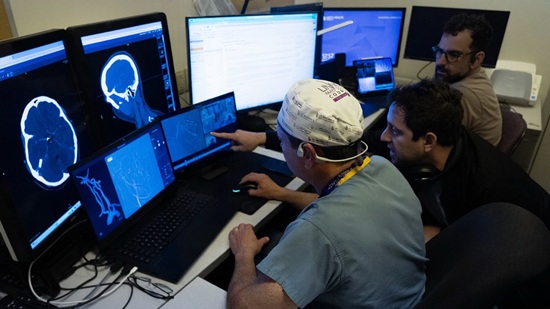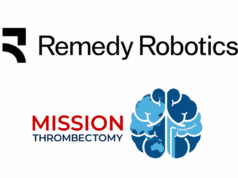 Remedy Robotics has debuted what it claims is the “world’s first” remotely operable endovascular robotic platform: the Remedy N1 system. A press release from the company notes that, by combining proprietary hardware with artificial intelligence (AI)-enabled software, the N1 system enables clinicians to deliver faster, safer and more effective interventional treatments to patients with conditions including stroke, heart attack, or vascular trauma—whether they are in the same room or on the other side of the globe.
Remedy Robotics has debuted what it claims is the “world’s first” remotely operable endovascular robotic platform: the Remedy N1 system. A press release from the company notes that, by combining proprietary hardware with artificial intelligence (AI)-enabled software, the N1 system enables clinicians to deliver faster, safer and more effective interventional treatments to patients with conditions including stroke, heart attack, or vascular trauma—whether they are in the same room or on the other side of the globe.
“Performing minimally invasive cardiovascular interventions with this level of robotic assistance, and entirely remotely, is absolutely transformative, even for experts in the field,” commented Vitor Pereira (University of Toronto, Toronto, Canada), who led a recently completed series of the first ever in-human procedures with Remedy’s N1 system. “The Remedy N1 system delivers exceptional manoeuvrability, dexterity, and visual clarity, enabling precise control and a significantly enhanced patient experience. The success of these world-first, in-human, remote procedures is a strong validation of the platform’s precision, safety and potential to transform patient care globally.”
The aforementioned procedures included fully remote operations conducted between two separate hospitals within the Unity Health Toronto network: St Michael’s Hospital and St Joseph’s Health Centre (both Toronto, Canada). According to the company, these procedures represent “the world’s first entirely remotely operated endovascular interventions”, having required no bedside interventionist.
“By successfully completing these remote procedures in humans, we’re not just introducing a breakthrough technology—we’re taking the real steps towards ensuring that every person around the world has access to the best possible endovascular care,” said David Bell, chief executive officer (CEO) and co-founder of Remedy. “This milestone is a testament to our team’s dedication and our commitment to partnering with leading clinicians and institutions, like Vitor Pereira and Unity Health Toronto. Together, we’re building a solution that will transform cardiovascular care globally.”
“The Remedy N1 system represents the next generation of surgical robotics, using advanced AI and machine learning to enable clinicians to operate robotically with a degree of visibility, precision and control that has never before been possible,” added Jake Sganga, chief technology officer (CTO) and co-founder of Remedy. “The system is engineered for scalability, allowing for straightforward deployment at virtually any hospital and, for the first time, allowing clinicians to complete entire endovascular procedures remotely from start to finish. The N1 system will allow every hospital to provide safe and precise endovascular intervention for cardiovascular procedures, and will empower physicians to provide expert care wherever it’s needed.”
According to Remedy, the N1 system includes an endovascular robot that “integrates seamlessly” into any cath lab and AI-enabled software for precise, safe control of multiple tools simultaneously. It features 360-degree catheters for safe navigation through the vasculature, built-in connectivity with image streaming and latency management for seamless remote operation, and an integrated contrast injector that allows operators to manage all aspects of the procedure. Additionally, the system supports audio-visual communication between the cath lab and the remote operator, and includes a simple, portable operator console designed for easy deployment both within and outside hospital environments.
Remedy states in its recent press release that the N1 system remains under development and is not yet available for sale.










